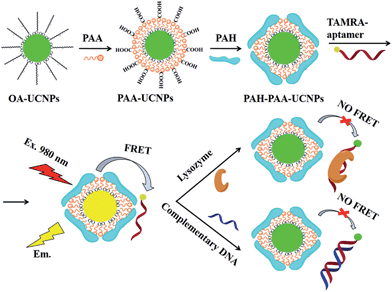A simple strategy based on upconversion nanoparticles for a fluorescent resonant energy transfer biosensor†
Abstract
A novel aptasensor was fabricated for the detection of lysozyme and DNA based on the fluorescence resonance energy transfer (FRET) technique between upconversion nanoparticles (UCNPs) and a dye labeled aptamer. UCNPs can act as excellent emitters due to their low autofluorescence and high penetration depth of biosamples. NaYF4:Yb, Er nanoparticles as UCNPs were synthesized and attached with a dye labeled aptamer through a cationic polymer as an electrostatic linker to quench the upconversion fluorescence intensity. The intensity can be restored after the addition of lysozyme or the complementary DNA (target DNA) because of their strong interaction with the aptamer. The sensor provided a linear concentration range from 30 to 210 nM for lysozyme and 40 to 200 nM for the target DNA, the limit of detection was 2.5 nM and 2.8 nM, respectively. The sensor was also used to monitor the lysozyme level in both human saliva and serum samples, and the results were consistent with the reported values. The method was simple and convenient without the extra procedure of bioconjugation, and could be put to use for the determination of various targets in the future.


 Please wait while we load your content...
Please wait while we load your content...